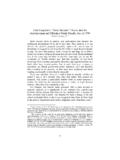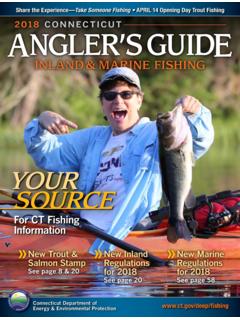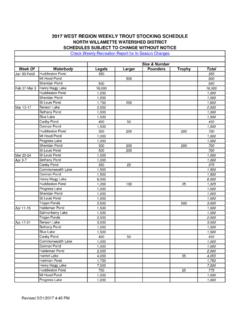Transcription of Methodology for Identification of Intermittent and ...
1 North Carolina Division of Water Quality Methodology for Identification of Intermittent and perennial streams and Their Origins Version Effective Date: September 1, 2010 This document should be cited as: NC Division of Water Quality. 2010. Methodology for Identification of Intermittent and perennial streams and their Origins, Version North Carolina Department of Environment and Natural Resources, Division of Water Quality. Raleigh, NC. Further Information can be obtained from: North Carolina Division of Water Quality Wetlands and Stormwater Branch Program Development Unit 1650 Mail Service Center Raleigh, NC 27699-1650 (919) 733-1786 Copies of this document are available through the internet: Table of Contents Introduction.
2 4 Purpose and Need .. 4 Development and Implementation Process .. 6 History of the Stream Identification Manual and Forms .. 6 Scientific Justification .. 7 Suggested Field Equipment .. 9 Basic rules for making stream determinations .. 9 Scoring .. 10 Sources of Variability .. 11 Ditches and Modified Natural Streams .. 12 Field Form Indicators and Descriptions .. 12 A. Geomorphic Indicators .. 12 1. Continuity of Channel Bed and Bank .. 12 2. Sinuosity of Channel Along Thalweg .. 13 3. In-channel structure: Riffle-Pool, Step-Pool, Ripple-Pool sequence .. 14 4. Particle Size in Stream Substrate.
3 15 5. Active/Relict Floodplain .. 16 6. Depositional Bars or Benches .. 17 7. Recent Alluvial Deposits .. 18 8. Headcuts .. 19 9. Grade Control .. 20 10. Natural Valley .. 21 11. Second (or Greater) Order Channel .. 22 B. Hydrologic Indicators .. 22 12. Presence of Baseflow .. 22 13. Iron Oxidizing Bacteria .. 23 14. Leaf litter .. 24 15. Sediment on Plants or Debris .. 25 16. Organic Drift Lines .. 25 17. Soil-based Evidence of a Seasonal High Water Table .. 26 i C. Biological Indicators .. 28 18. Fibrous Roots in Streambed .. 28 19. Rooted Upland Plants in Streambed .. 29 20. Benthic Macroinvertebrates.
4 29 21. Aquatic Mollusks .. 30 22. Fish .. 31 23. Crayfish .. 31 24. Amphibians .. 32 25. Algae .. 33 26. Wetland Plants in Streambed .. 34 Background .. 35 Recent and on-going Investigations .. 35 NC DWQ Policy for the Definition of Perennial Stream Origins .. 35 Special Provision for Coastal Plain Streams .. 37 History of the Guidance for the Determination of the Origin of perennial streams .. 37 NC DWQ Stream Identification Form Version .. 41 List of Figures Figure 1: Streamflow sources .. 8 Figure 2: Illustration of perennial and Intermittent surface flow intersecting .. 8 Figure 3: Stream sinuosity.
5 13 Figure 4: Examples of stream sinuosity .. 14 Figure 5: Riffle-pool and step-pool stream morphologies.. 14 Figure 6: Examples of sediment sizes in the substrate .. 16 Figure 7: Illustration of abandoned floodplain relative to stream and active floodplain .. 17 Figure 8: Plan view of depositional bars in straight, braided and meandering streams .. 17 Figure 9: Bankfull bench and related stream features .. 18 Figure 10: Recent alluvial deposits.. 19 Figure 11: Headcut 19 Figure 12: Examples of headcuts .. 20 Figure 13: Example of grade control in Umstead State Park, Wake County NC.. 21 Figure 14: Illustration of groundwater flow and hyporheic.
6 23 Figure 15: Iron oxidizing bacteria.. 24 ii iii Figure 16: Example of soil features .. 28 Figure 17: Benthic macroinvertebrates .. 30 Figure 18: Fingernail claims .. 31 Figure 19: Salamander .. 33 Figure 20: Algae and moss .. 34 List of Tables Table 1: Guide to scoring categories .. 11 Table 2: Ephemeroptera, Plecoptera and Trichoptera (EPT) perennial stream indicator .. 36 Table 3: Additional indicators of perennial streams .. 36 NC Division of Water Quality Methodology for Identification of Intermittent and perennial streams and Their Origins v. 4 SECTION 1 Stream Identification Methodology Introduction This stream Identification Methodology is intended to guide natural resource professionals in the Identification of ephemeral, Intermittent and perennial streams using geomorphic, hydrologic and biological stream features.
7 This manual and accompanying field form can be used to identify points on the landscape that represent stream origins and to determine whether a stream is ephemeral, Intermittent or perennial in reaches that are some distance downstream of an origin. The manual focuses on headwater streams and the characteristic features of low-order streams wherever they occur in a watershed. Section 1 provides the background and scientific justification for the Methodology . Section 2 outlines the field method and use of the rating form. Section 3 provides details on additional procedures for determination of a perennial stream.
8 Version of the manual replaces Version (February 28, 2005) and reflects five years of regulatory and academic experience gained since the version Clarifications and edits were made in several areas throughout the document to provide additional background on the Methodology and improve readability of the manual. Changes to the indicators in the Methodology were made for clarification purposes only and do not affect the total scores for stream evaluations or the stream determination made by professionals using the Methodology . Changes made to indicators and scoring on the stream form from version to can be found at on the DWQ website.
9 Purpose and Need The Methodology for Identification of Intermittent and perennial streams and Their Origins and numerical rating system were developed in response to requests from the North Carolina regulated community for an objective method to identify ephemeral, Intermittent and perennial streams . The need for a stream Identification Methodology resulted from implementation of the Neuse River Basin Riparian Buffer Rules mandating buffers on all Intermittent and perennial streams in the basin. The Methodology has since been implemented for other river basins in the state that have riparian buffer rules as well as for stream Identification related to stream mitigation.
10 The definitions of ephemeral, Intermittent and perennial streams are part of the North Carolina Administrative Code (NCAC) and the methods are tailored to these regulatory definitions. Complete language for the rules can be found at: \Title%2015A%20-%20 Environment%20and%20 Natural%20 Resources The regulatory definitions of streams and related terms are below. Citation of the appropriate section of the North Carolina Administrative Code (NCAC) is shown in parentheses following each definition. Stream means a body of concentrated flowing water in a natural low area or natural channel on the land surface.







